Abstract
The idea of having two second messenger pathways in olfaction, one mediated by cAMP and the other by inositol 1,4,5-trisphosphate, is supported by evidence that both second messengers directly activate distinct ion channels in the outer dendrite of lobster olfactory receptor neurons. Evidence that both types of second messenger-gated channels can occur in the same patch of membrane suggests that channels of both types can be expressed in one neuron. Evidence of more than one type of inositol phosphate-gated channel in this highly specialized region of the neuron furthers the idea that the output of individual olfactory receptor cells is regulated through multiple effectors and allows that effector diversity may contribute to functional diversity among olfactory receptor cells.
Full text
PDF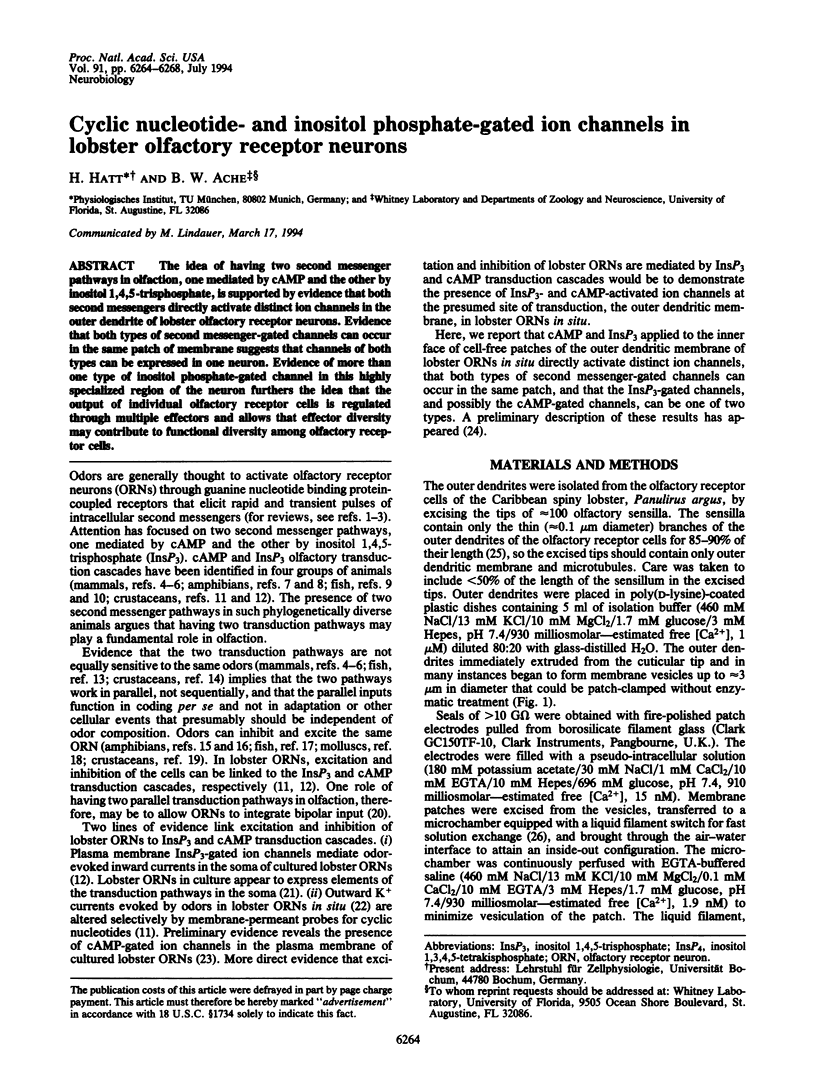
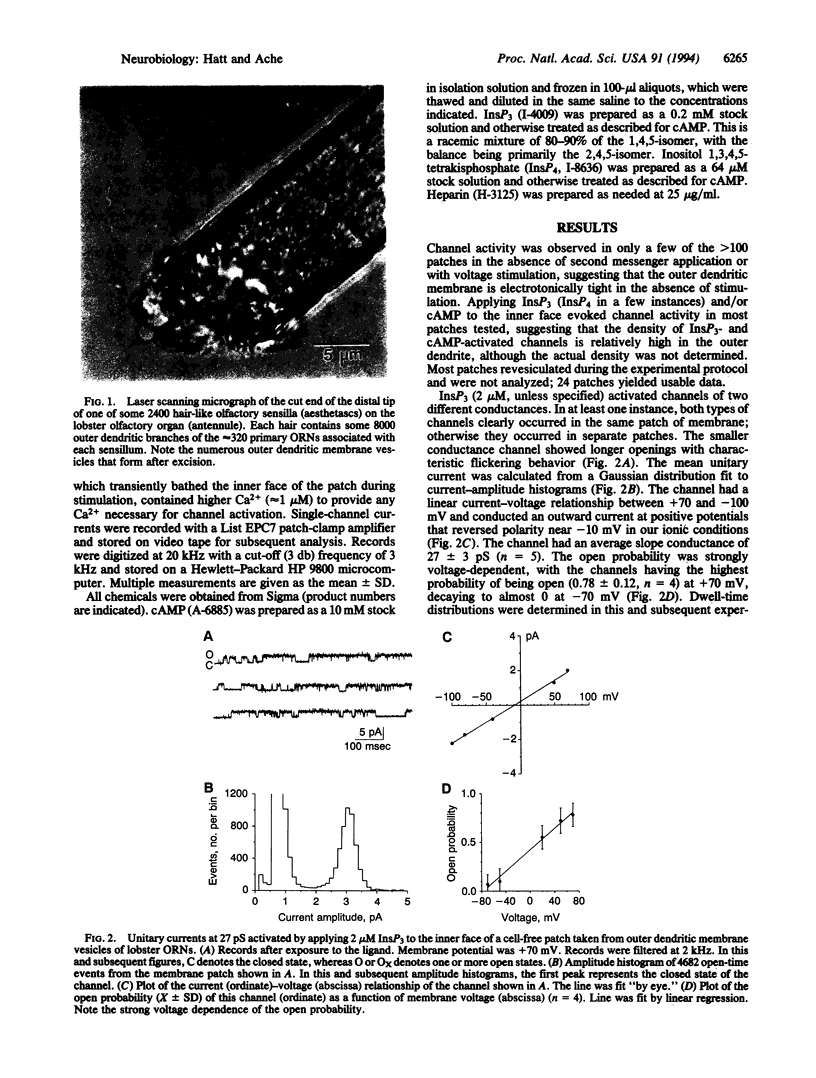
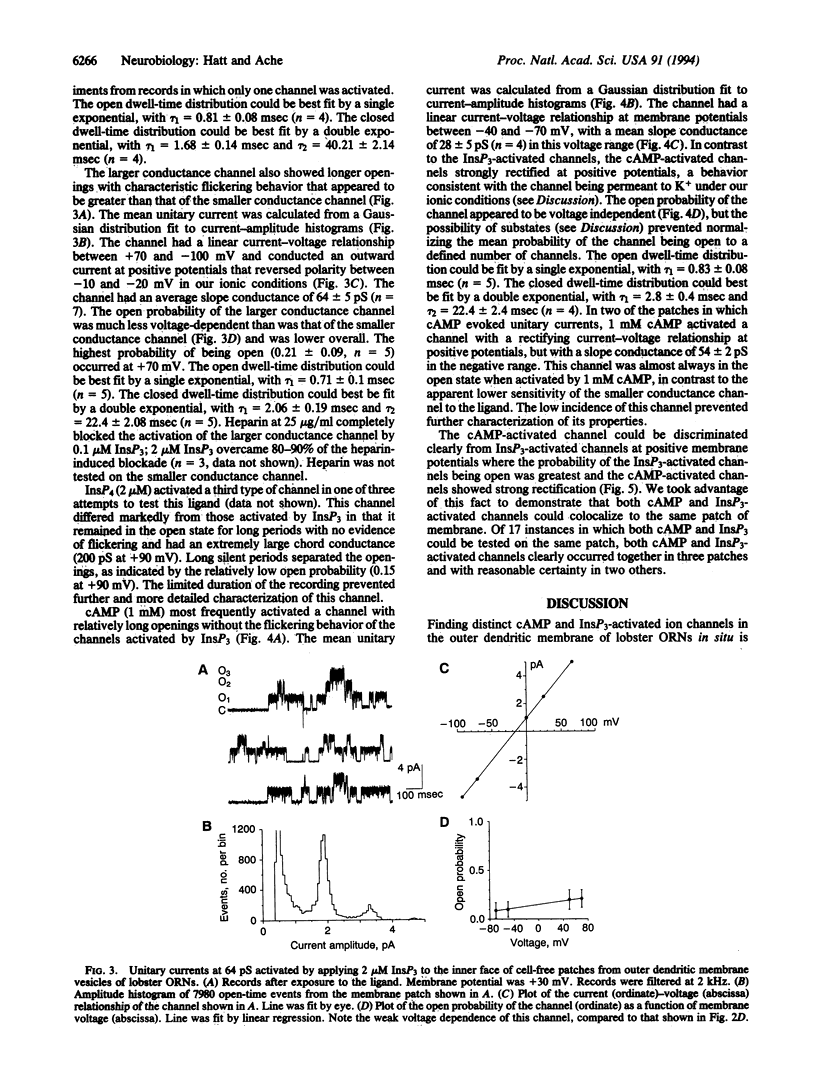
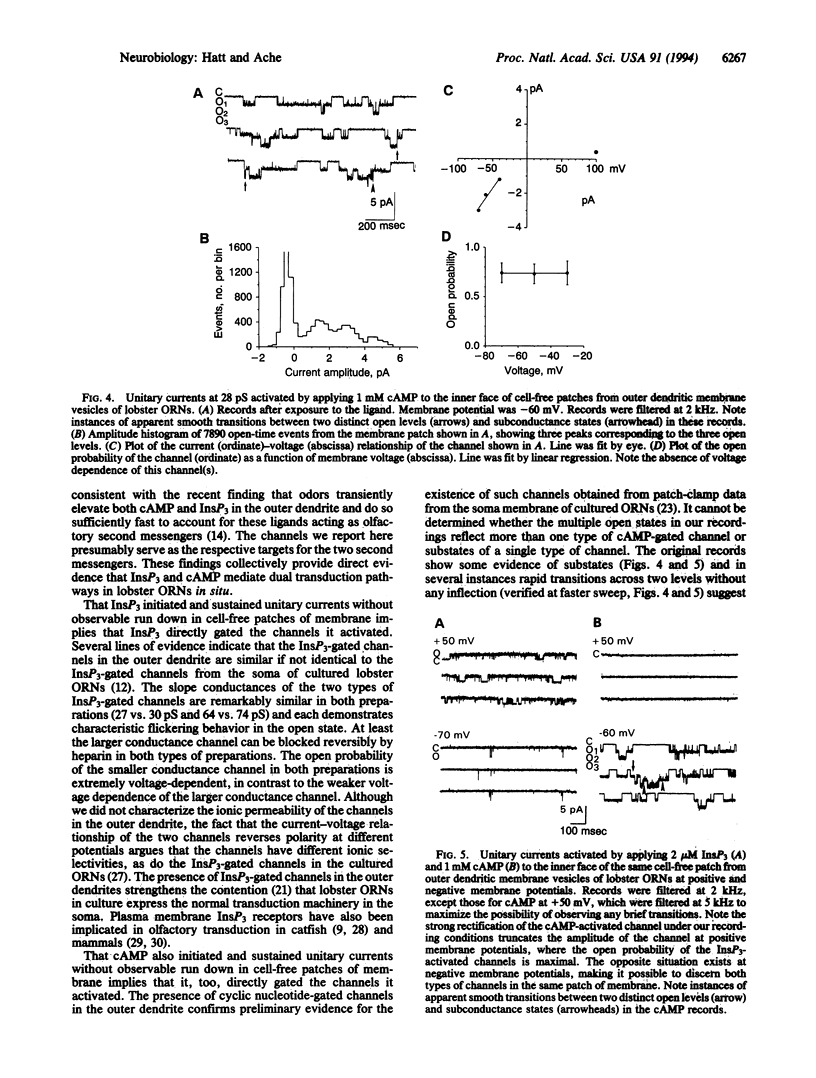
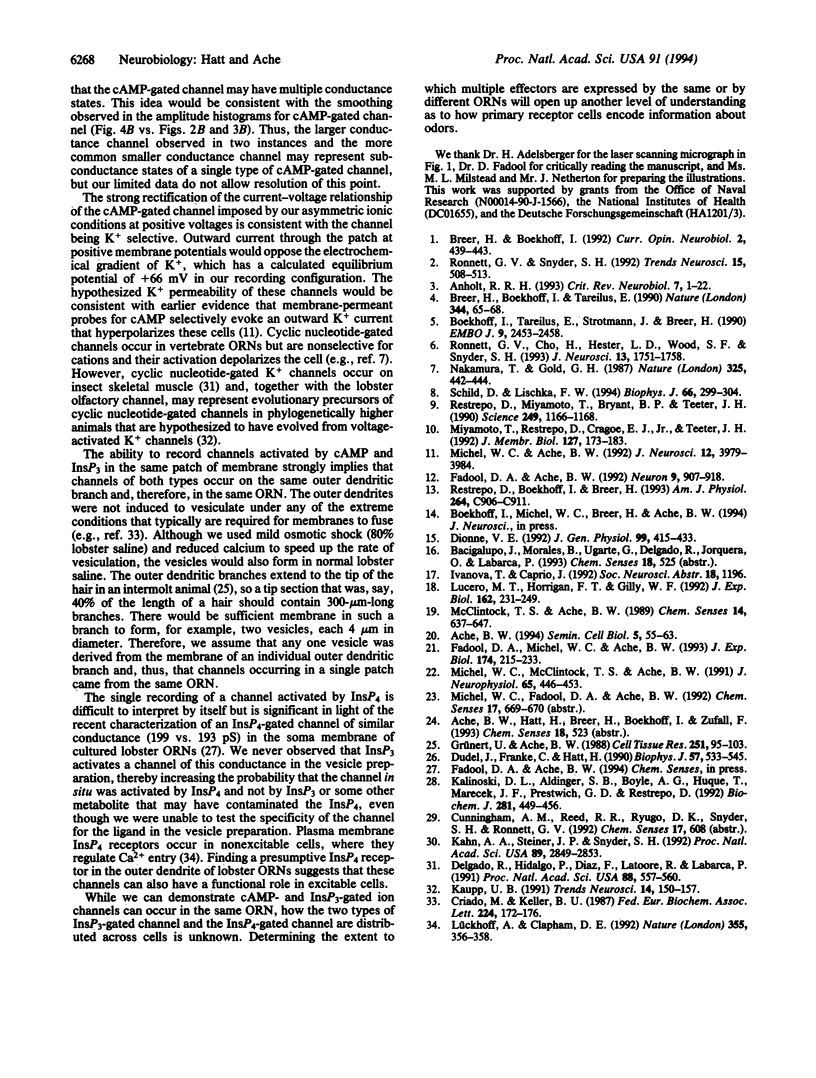
Images in this article
Selected References
These references are in PubMed. This may not be the complete list of references from this article.
- Ache B. W. Towards a common strategy for transducing olfactory information. Semin Cell Biol. 1994 Feb;5(1):55–63. doi: 10.1006/scel.1994.1008. [DOI] [PubMed] [Google Scholar]
- Anholt R. R. Molecular neurobiology of olfaction. Crit Rev Neurobiol. 1993;7(1):1–22. [PubMed] [Google Scholar]
- Boekhoff I., Tareilus E., Strotmann J., Breer H. Rapid activation of alternative second messenger pathways in olfactory cilia from rats by different odorants. EMBO J. 1990 Aug;9(8):2453–2458. doi: 10.1002/j.1460-2075.1990.tb07422.x. [DOI] [PMC free article] [PubMed] [Google Scholar]
- Breer H., Boekhoff I. Second messenger signalling in olfaction. Curr Opin Neurobiol. 1992 Aug;2(4):439–443. doi: 10.1016/0959-4388(92)90177-m. [DOI] [PubMed] [Google Scholar]
- Breer H., Boekhoff I., Tareilus E. Rapid kinetics of second messenger formation in olfactory transduction. Nature. 1990 May 3;345(6270):65–68. doi: 10.1038/345065a0. [DOI] [PubMed] [Google Scholar]
- Criado M., Keller B. U. A membrane fusion strategy for single-channel recordings of membranes usually non-accessible to patch-clamp pipette electrodes. FEBS Lett. 1987 Nov 16;224(1):172–176. doi: 10.1016/0014-5793(87)80442-8. [DOI] [PubMed] [Google Scholar]
- Delgado R., Hidalgo P., Diaz F., Latorre R., Labarca P. A cyclic AMP-activated K+ channel in Drosophila larval muscle is persistently activated in dunce. Proc Natl Acad Sci U S A. 1991 Jan 15;88(2):557–560. doi: 10.1073/pnas.88.2.557. [DOI] [PMC free article] [PubMed] [Google Scholar]
- Dionne V. E. Chemosensory responses in isolated olfactory receptor neurons from Necturus maculosus. J Gen Physiol. 1992 Mar;99(3):415–433. doi: 10.1085/jgp.99.3.415. [DOI] [PMC free article] [PubMed] [Google Scholar]
- Dudel J., Franke C., Hatt H. Rapid activation, desensitization, and resensitization of synaptic channels of crayfish muscle after glutamate pulses. Biophys J. 1990 Mar;57(3):533–545. doi: 10.1016/S0006-3495(90)82569-8. [DOI] [PMC free article] [PubMed] [Google Scholar]
- Fadool D. A., Ache B. W. Plasma membrane inositol 1,4,5-trisphosphate-activated channels mediate signal transduction in lobster olfactory receptor neurons. Neuron. 1992 Nov;9(5):907–918. doi: 10.1016/0896-6273(92)90243-7. [DOI] [PMC free article] [PubMed] [Google Scholar]
- Fadool D. A., Michel W. C., Ache B. W. Odor sensitivity of cultured lobster olfactory receptor neurons is not dependent on process formation. J Exp Biol. 1993 Jan;174:215–233. doi: 10.1242/jeb.174.1.215. [DOI] [PubMed] [Google Scholar]
- Kalinoski D. L., Aldinger S. B., Boyle A. G., Huque T., Marecek J. F., Prestwich G. D., Restrepo D. Characterization of a novel inositol 1,4,5-trisphosphate receptor in isolated olfactory cilia. Biochem J. 1992 Jan 15;281(Pt 2):449–456. doi: 10.1042/bj2810449. [DOI] [PMC free article] [PubMed] [Google Scholar]
- Kaupp U. B. The cyclic nucleotide-gated channels of vertebrate photoreceptors and olfactory epithelium. Trends Neurosci. 1991 Apr;14(4):150–157. doi: 10.1016/0166-2236(91)90087-b. [DOI] [PubMed] [Google Scholar]
- Khan A. A., Steiner J. P., Snyder S. H. Plasma membrane inositol 1,4,5-trisphosphate receptor of lymphocytes: selective enrichment in sialic acid and unique binding specificity. Proc Natl Acad Sci U S A. 1992 Apr 1;89(7):2849–2853. doi: 10.1073/pnas.89.7.2849. [DOI] [PMC free article] [PubMed] [Google Scholar]
- Lückhoff A., Clapham D. E. Inositol 1,3,4,5-tetrakisphosphate activates an endothelial Ca(2+)-permeable channel. Nature. 1992 Jan 23;355(6358):356–358. doi: 10.1038/355356a0. [DOI] [PubMed] [Google Scholar]
- Michel W. C., Ache B. W. Cyclic nucleotides mediate an odor-evoked potassium conductance in lobster olfactory receptor cells. J Neurosci. 1992 Oct;12(10):3979–3984. doi: 10.1523/JNEUROSCI.12-10-03979.1992. [DOI] [PMC free article] [PubMed] [Google Scholar]
- Michel W. C., McClintock T. S., Ache B. W. Inhibition of lobster olfactory receptor cells by an odor-activated potassium conductance. J Neurophysiol. 1991 Mar;65(3):446–453. doi: 10.1152/jn.1991.65.3.446. [DOI] [PubMed] [Google Scholar]
- Miyamoto T., Restrepo D., Cragoe E. J., Jr, Teeter J. H. IP3- and cAMP-induced responses in isolated olfactory receptor neurons from the channel catfish. J Membr Biol. 1992 May;127(3):173–183. doi: 10.1007/BF00231505. [DOI] [PubMed] [Google Scholar]
- Nakamura T., Gold G. H. A cyclic nucleotide-gated conductance in olfactory receptor cilia. 1987 Jan 29-Feb 4Nature. 325(6103):442–444. doi: 10.1038/325442a0. [DOI] [PubMed] [Google Scholar]
- Restrepo D., Boekhoff I., Breer H. Rapid kinetic measurements of second messenger formation in olfactory cilia from channel catfish. Am J Physiol. 1993 Apr;264(4 Pt 1):C906–C911. doi: 10.1152/ajpcell.1993.264.4.C906. [DOI] [PubMed] [Google Scholar]
- Restrepo D., Miyamoto T., Bryant B. P., Teeter J. H. Odor stimuli trigger influx of calcium into olfactory neurons of the channel catfish. Science. 1990 Sep 7;249(4973):1166–1168. doi: 10.1126/science.2168580. [DOI] [PubMed] [Google Scholar]
- Ronnett G. V., Cho H., Hester L. D., Wood S. F., Snyder S. H. Odorants differentially enhance phosphoinositide turnover and adenylyl cyclase in olfactory receptor neuronal cultures. J Neurosci. 1993 Apr;13(4):1751–1758. doi: 10.1523/JNEUROSCI.13-04-01751.1993. [DOI] [PMC free article] [PubMed] [Google Scholar]
- Ronnett G. V., Snyder S. H. Molecular messengers of olfaction. Trends Neurosci. 1992 Dec;15(12):508–513. doi: 10.1016/0166-2236(92)90104-g. [DOI] [PubMed] [Google Scholar]
- Schild D., Lischka F. W. Amiloride-insensitive cation conductance in Xenopus laevis olfactory neurons: a combined patch clamp and calcium imaging analysis. Biophys J. 1994 Feb;66(2 Pt 1):299–304. doi: 10.1016/s0006-3495(94)80804-5. [DOI] [PMC free article] [PubMed] [Google Scholar]



